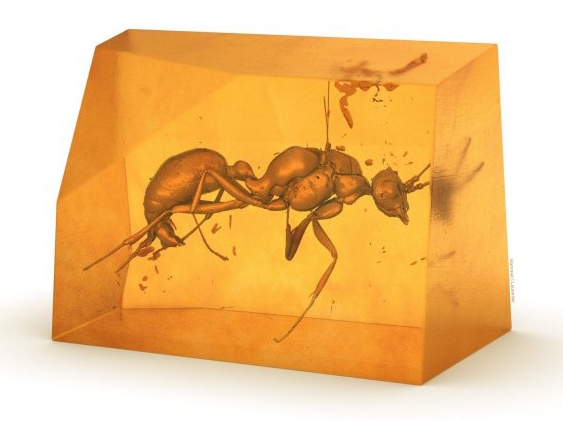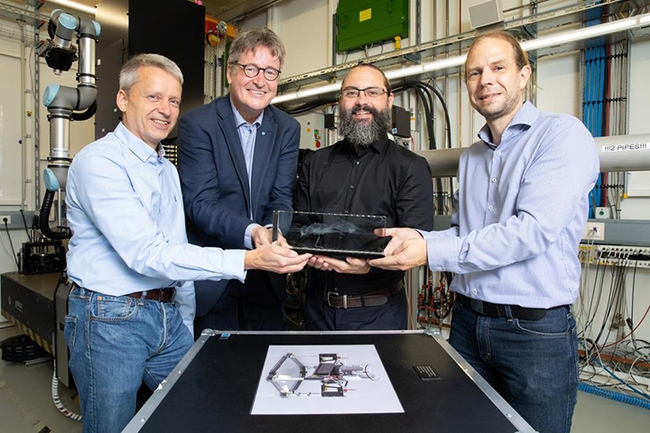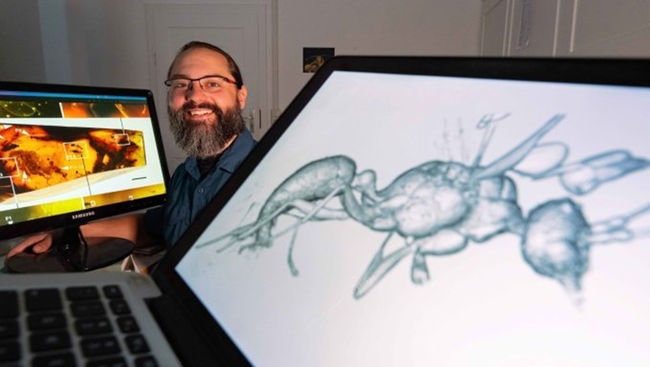- Author: Kathy Keatley Garvey

It involves fossilized male ants, estimated to be about 20 million years and encased in Ethiopian amber.
And a talented young UC Davis doctoral alumnus and ant specialist who's an Alexander von Humboldt Research Fellow at the Institute of Zoology and Evolutionary Research at Friedrich Schiller University Jena.
Basically, an international team scientists led by Friedrich Schiller University Jena and including key researcher and lead author Brendon Boudinot, the UC Davis doctoral alumnus, discovered a new genus of an extinct ant. Their work, international newly published in the journal Insects, is drawing international attention and rightfully so.
The researchers examined 13 individual male fossilized ants that lived during the Miocene epoch and identified them as a new genus of primordial ants. The team used the X-ray light source PETRA III at the German Electron Synchrotron (DESY) in Hamburg, aided by state-of-the-art imaging technology. The name given to the new species and genus: "†Desyopone hereon gen. et sp. nov," to honor the two research institutions involved--DESY and Hereon.
The males resemble species of the relictual lineage Aneuretinae, "but which effectively belong to the Ponerinae, as revealed by advanced 3D-imaging technology (synchrotron radiation micro-computed tomography, SR-µ-CT)," the authors wrote. "We subsequently propose a revision of ant classification at the subfamily level. We also recognize that the new species belongs to a new genus based on recent phylogenomic results that have clarified the generic boundaries of Ponerini ants. Our work, therefore, represents an example of reciprocal illumination between phenomic and genomic data."
"The study was really pleasing from a scientific perspective, as we were able to pass through the whole cycle of hypothesis induction based on the original light microscopy, then deductive prediction for structures we then tested using synchrotron radiation, which allowed us to reject the initial hypothesis—and to go even further!" said Boudinot, an Alexander von Humboldt Research Fellow at the Institute of Zoology and Evolutionary Research at Friedrich Schiller University Jena.
"There are a couple of important elements to the study," Boudinot said. "Based on this discovery, we had to redefine two ant subfamilies and two tribes, and we demonstrate the value of the oft-neglected male ants for understanding evolution through the comparison of mandibles of male and females across the phylogeny, revealing a major trend in mandible evolution. In the bigger picture, what I think is significant is that this work marks a boundary for ant paleontology, where we will increasingly be able to use x-ray micro-computed tomography (µ-CT) to generate 3D models for study and quantitative analysis. Soon, we will be able to analyze these phenomic data simultaneously with genomic data. The study of ant morphology and paleontology is transforming and becoming 'big data'! There will be lots more work to come."
The team, in addition to researchers from Friedrich Schiller University Jena, included scientists from the University of Rennes in France, the University of Gdansk in Poland, and the Helmholtz-Zentrum Hereon in Geesthacht, Germany.
In a University of Jena news release, Vincent Perrichot from the University of Rennes explained: "The piece with these ants is from the only amber deposit in Africa so far that has featured fossil organisms in inclusions. Altogether, there are only a few fossil insects from this continent. Although amber has long been used as jewelry by locals in the region, its scientific significance has only become clear to researchers in the last 10 years or so. The specimen therefore offers what is currently a unique insight into an ancient forest ecosystem in Africa.” Its complicated dating was possible only indirectly, by determining the age of the fossil palynomorphs--the spores and pollen--enclosed in the amber, he added.
"Research results such as these are only possible through the use of state-of-the-art technology," according to the University of Jena news release. "As the genetic material of fossils cannot be analyzed, precise data and observations on the morphology of animals are particularly important. Comprehensive data can be obtained using high-resolution imaging techniques, such as micro-computed tomography (CT), in which X-rays are used to look through all layers of the sample."
A quote from Jörg Hammel from the Helmholtz-Zentrum Hereon: “Since the ants enclosed in amber that are to be examined are very small and only show a very weak contrast in classical CT, we carried out the CT at our measuring station, which specializes in such micro-tomography. This provided the researchers with a stack of images that basically showed the sample that was being studied slice by slice.”
"Put together, these produced detailed three-dimensional images of the internal structure of the animals, which the researchers could use to reconstruct the anatomy with precision," the news release related. "This was the only way to exactly identify the details that ultimately led to the new species and genus being determined."
Boudinot, a two-year Alexander von Humboldt Research Fellow, recently was awarded a Peter S. Buck Research Fellowship at the Smithsonian Institution, Washington, D.C., and will begin his fellowship there early next year.
Highly honored for his academics, leadership, public service activities, professional activities and publications while at UC Davis, Boudinot received his doctorate in entomology in 2020, working with major professor Phil Ward. Boudinot's many honors: the John Henry Comstock Award from the Pacific Branch, Entomological Society of America, the highest ESA graduate student honor; and the coveted Robert E. Snodgrass Memorial Research Award (2020) from the Entomological Society of America (ESA).
Boudinot served on—and anchored—three of the UC Davis Linnaean Games teams that won national or international ESA championships. The Linnaean Games, now known as the Entomology Games, are a lively question-and-answer, college bowl-style competitions on entomological facts played between university-sponsored student teams.




